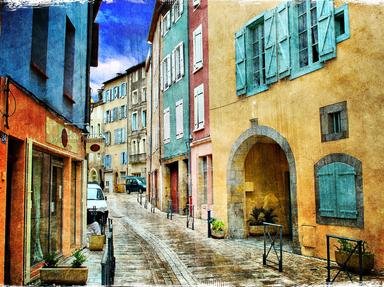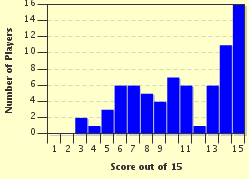Quiz Answer Key and Fun Facts
1. Bon jour mes amis! Habrok the hawk here! I come and I go, comme ci, comme ca, in and out of the pictures, embroidered with blue, green, gold and brown wool yarn on a 70 metre strip of woven linen.
The Bayeux Tapestry depicts the events leading up to the Norman Conquest of Britain in 1066.
What region in France is "home" to the Bayeux Tapestry?
2. Bon jour again! Il fait beau, n'est pas? I'd better bring you up to date with my news, oui? In the first scene in the tapestry, I'm sitting on Harold's hand as he talks to his brother-in-law the king. Am I not a fine bird? You'll see in the next scene how after a feast we went to church to pray for a good voyage and then, still sitting on his hand, I accompanied him across La Manche to Normandy.
By the way, I keep mentioning the king. Who is this king of England depicted in the first scenes of the tapestry ?
3. What a day yesterday was! I did meet Ethelfleda though. She's a fast little bird with bright black eyes and you can see her on the tapestry sitting on Count Robert's hand. Count Robert? Oh, he's the fierce Count of Mortmain, William the Conqueror's half brother, and he guards the southern border of Normandy. You can see him on the tapestry between William and Odo. (I'm hiding in the border!)
Robert took us prisoner when we landed but William sent messengers demanding our release. So it's "Au revoir, Ethelfleda! Je suis desole!" Wouldn't we have made a wonderful pair?
What two main stitches do these clever ladies use to make us all so charming?
4. Now we come to a rather strange section. It begins well. How could it not, for I am there on the hand of William himself travelling with Harold to William's Palace at Rouen. But look at the right side of the section. What's going on there? Oh, ma foi! It seems to be a mysterious lady who seems to be being molested. I wonder what that's all about?
Just as I was about to fly into the border I saw something that made my feathers curl. There's a man down there with no clothes on. I feel quite faint. Someone else had better ask the question.
When Victorian embroiderers made a copy of the tapestry in 1885 what change did they make to this scene?
5. Brr-rr-rr! I'm not too keen on water and I've just had quite a narrow escape. Il fait froid! In the next three scenes, Harold and the Norman soldiers are going with William to fight Conan of Brittany. They have to cross a river and you can see Harold pulling out some soldiers who have slipped - two at a time! You can't see me. I don't like wet feathers!
As they pursue and finally defeat Conan they have to pass by his capital which can be clearly seen atop a mound.
What is the Brittany capital, seen on the tapestry?
6. The next tapestry section is the Oath of Allegiance. This infamous oath to Duke William was described by the Anglo-Norman historian Orderic Vitalis -
"Harold himself had taken an oath of fealty to Duke William at Rouen in the presence of the Norman nobles, and, after becoming his man, had sworn ... to carry out all that was required of him. After that, the Duke had taken Harold on an expedition against Conan, Count of Brittany, and had given him splendid arms and horses and heaped other tokens upon him and his companions."
The Bayeux Tapestry depicts this critical event. William is illustrated as calling upon Harold to swear an oath of allegiance to him and to his right to the throne. The Tapestry shows Harold swearing his oath as William looks on.
Why does Harold have his hands on what appears to be two large box-like containers?
7. Bonjour again mes amis. Comment ca va? I haven't seen you lately but I've been keeping an eye on things. I don't trust that William. I think he makes Harold a bit of a stool pigeon. But things are sad just now. The king looks very sick. The titulus or sentence above the scene says that Harold has come back to see the king.
What language is the wording on the tapestry written in?
8. The king is dead!
Edward died on the 5th January 1066. The Tapestry reverses the scenes of his death and his burial. First we see his funeral procession to his great new Church. Edward had been too ill to attend its consecration on 28th December 1065. In the upper chamber King Edward is in his bed talking to his faithful followers, including Harold and Queen Edith - below he is shown dead with a priest in attendance. Two noblemen offer Harold the crown and axe, symbols of royal authority, that will make him King. He accepts the offer.
What is the great new Church, consecrated in December 1065, where Edward was buried?
9. Hello, friends. I, Habrok the Hawk, devourer of the unwary, have a confession to make. I have been hiding. I have been very scared. At Harold's coronation a wondrous thing happened. Maybe it was an omen ...
What strange phenomenon is depicted in the tapestry?
10. News of Edward's death and Harold's coronation is carried across the channel to William who is furious. He decides to attack England and organises a fleet of warships. To his left sits Bishop Odo of Bayeux, his half-brother.
What do we see his men doing to prepare for war?
11. In the two scenes representing the crossing William is seen leading his army to the boats and setting sail. The sea is crowded with ships, full of soldiers and horses. William sails in the ship, Mora, bought for him by his wife Matilda.
For a figurehead it has the image of a child with its right hand pointing towards England and with a silver trumpet in its mouth. In the embroidered scene the Papal banner can be seen at the masthead.
What colour and design is the Papal banner?
12. There would be no English army to oppose William's landing at Pevensey and later Hastings, since Harold was in the North at Stamford Bridge roundly defeating Norwegian Harald and Harold's own brother Tosti. The Normans prepare a feast in the open air - chickens on skewers, a stew cooked over an open fire and food from an outdoor oven. William sits down to a feast with his nobles and Bishop Odo says grace.
What are the servants depicted as using shields for?
13. The battle rages on. Men and horses crash to the ground and the lower border is strewn with slaughtered troops and animals. Bishop Odo appears in the thick of the fighting waving a club and encouraging his followers. Odo uses a club rather than a sword.
Why is Odo shown using a club?
14. The battle is over! There is no room for me, Habrok the Hawk, to hide in the borders of this horrible penultimate scene. It is Harold's death scene and the borders are full of dead, dying or dismembered men.
What was supposedly the cause of Harold's death, as shown here?
15. Au revoir, mes amis, We shall not hunt together again I think! I shall be fine. I turn my feathers easily! We may meet again. Look for me in William's court. I may not always be beautifully stitched. I may be painted or engraved. Who knows?
In this rather heavily restored final scene we see Normans pursuing rustics far into the night. The pursued are carrying maces. Why is this strange?
Source: Author
balaton
This quiz was reviewed by FunTrivia editor
looney_tunes before going online.
Any errors found in FunTrivia content are routinely corrected through our feedback system.

